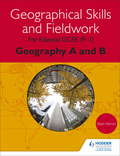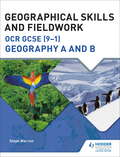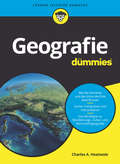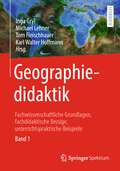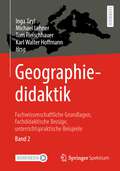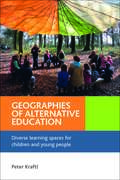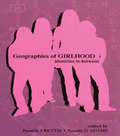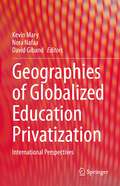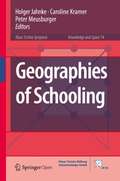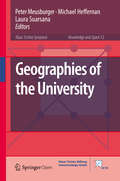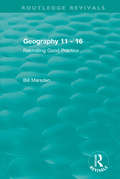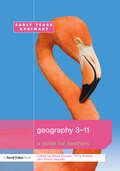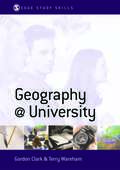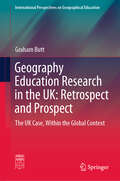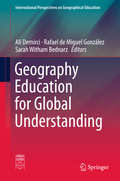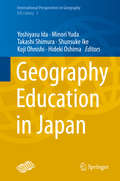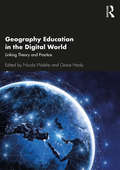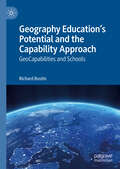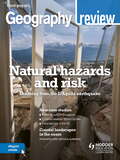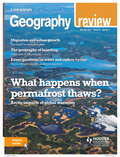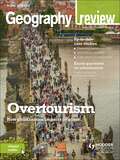- Table View
- List View
Geographical Skills and Fieldwork for Edexcel GCSE (91) Geography A and B
by Steph WarrenMaximise every student's grade potential with a step-by-step approach to learning, improving and applying the geographical and fieldwork skills they need to achieve stand-out success under the reformed Edexcel A and B GCSE Geography specifications.- Provides a complete, tailor-made solution to teaching the cartographic, graphical, numerical and statistical skills emphasised in the 2016 Edexcel A and B GCSE geography specifications- Helps you prepare students for the changed fieldwork assessments and new question formats with a dedicated section on geographical enquiries- Supports students of varying abilities by moving from clear explanations of each skill to easy-to-follow guidance on applying the skills in an examination context- Offers plenty of opportunities to put newly-acquired skills into practice through a range of activities for all learners, as well as extension tasks designed for students targeting the top grades- Boosts students' confidence tackling terminal assessment with skills-focused exam-style questions and insider tips on common question types and topics- Cuts down your marking time and enables students to monitor their own progress by including answers for every activity and exam-style question
Geographical Skills and Fieldwork for OCR GCSE (9–1) Geography A and B
by Steph WarrenMaximise every student's grade potential with a step-by-step approach to learning, improving and applying the geographical and fieldwork skills they need to achieve stand-out success under the reformed OCR A and B GCSE Geography specifications.- Provides a complete, tailor-made solution to teaching the cartographic, graphical, numerical and statistical skills emphasised in the 2016 OCR A and B GCSE Geography specifications- Helps you prepare students for the changed fieldwork assessments and new question formats with a dedicated section on geographical enquiries- Supports students of varying abilities by moving from clear explanations of each skill to easy-to-follow guidance on applying the skills in an examination context- Offers plenty of opportunities to put newly-acquired skills into practice through a range of activities for all learners, as well as extension tasks designed for students targeting the top grades- Boosts students' confidence tackling terminal assessment with skills-focused exam-style questions and insider tips on common question types and topics- Cuts down your marking time and enables students to monitor their own progress by including answers for every activity and exam-style question
Geographie für Dummies (Für Dummies)
by Charles A. HeatwoleBei der Geografie geht es längst nicht nur darum, zu wissen, wo welches Land oder welcher Fluss zu finden ist. "Geografie für Dummies" erklärt Ihnen, wie das geografische Koordinatensystem aufgebaut ist, wie man damit Orte bestimmt und so Karten richtig deutet. Im Mittelpunkt des Buches stehen die Geofaktoren Boden, Wasser und Klima und deren Wechselwirkungen miteinander: Wie formen Vulkane, Erosion und Wetter die Erdoberfläche? Wie beeinflussen die Ozeane das Klima? Und wie ist es möglich, dass Wüste und Regenwald nur durch eine Bergkette voneinander getrennt sind? Aber auch der Einfluss des Menschen kommt nicht zu kurz, so wird auch die urbane, politische und wirtschaftliche Geografie erläutert. Egal, ob Sie wissen möchten, wie das Klima die Erde beeinflusst oder wo ein günstiger Standort für das nächste Eigenheim wäre, dieses Buch liefert Ihnen alle Antworten.
Geographiedidaktik: Fachwissenschaftliche Grundlagen, fachdidaktische Bezüge, unterrichtspraktische Beispiele - Band 1
by Inga Gryl Michael Lehner Tom Fleischhauer Karl Walter HoffmannMit dem zweibändigen Werk liegt das erste deutschsprachige Lehrbuch zur Geographiedidaktik vor, welches konkret zum kreativen und praxistauglichen Verknüpfen von fachwissenschaftlichen und fachdidaktischen Bezügen anregt. Mit Hilfe eines „Didaktischen Mischpults“ sollen mannigfaltige didaktische Variations- und Kombinationsmöglichkeiten gelingen. Hierfür stehen neben dem klassischen Inhaltsverzeichnis fünf weitere Verzeichnisse zur Verfügung, die einen einfachen Zugriff auf die einzelnen Abschnitte der jeweiligen Beiträge (geographiedidaktische Bezüge, fachwissenschaftliche Bezüge, Basiskonzepte, Kompetenzen, räumliche Bezüge) ermöglichen und somit ein eigenständiges (Re-)Mixen erleichtern. Außerdem stehen zu vielen Beiträgen konkrete Arbeitsmaterialien und editierbare Druckvorlagen in einem digitalen Materialanhang bereit. Die Gesamtkonzeption des Werks betont die Interdisziplinarität des Fachs Geographie im Bezug zu Natur- und Gesellschaftswissenschaften und stellt die Verflechtung beider Bereiche als Normalfall dar. Mit Blick auf die fachwissenschaftlichen Bezugspunkte und die Orientierung in Lehrplänen werden in Band 1 naturwissenschaftliche und in Band 2 gesellschaftswissenschaftliche zentrierte Anwendungsbezüge dargestellt, aber stets mit interdisziplinären Bezügen im Bereich Mensch-Umwelt-System, da vor dem Hintergrund von Vernetzung und Komplexität keine scharfe Trennung möglich und sinnvoll ist. Beide Bände beinhalten zudem methodische Themen, die im Band 1 die technischen Grundlagen und im Band 2 die sozialgeographischen Implikationen in einer Kultur der Digitalität fokussieren. Die beiden Bände sind ein umfassendes Gemeinschaftswerk, das verschiedene Professionen und Expertisen vereint. Die 83 Autor*innen aus der gesamten deutschsprachigen Community der Geographiedidaktik sind in Schulpraxis, Lehramtsausbildung und/oder fachdidaktischer Forschung tätig. Leitend ist dabei eine theoretisch und empirisch fundierte, reflektierte Praxis. Damit richtet sich das Werk an Schulpraktiker*innen, Lehrer*innen, Referendar*innen, Studierende, Fachdidaktiker*innen, Lehramtsbildner*innen, Theoretiker*innen und Interessierte.
Geographiedidaktik: Fachwissenschaftliche Grundlagen, fachdidaktische Bezüge, unterrichtspraktische Beispiele - Band 2
by Inga Gryl Michael Lehner Tom Fleischhauer Karl Walter HoffmannMit dem zweibändigen Werk liegt das erste deutschsprachige Lehrbuch zur Geographiedidaktik vor, welches konkret zum kreativen und praxistauglichen Verknüpfen von fachwissenschaftlichen und fachdidaktischen Bezügen anregt. Mit Hilfe eines „Didaktischen Mischpults“ sollen mannigfaltige didaktische Variations- und Kombinationsmöglichkeiten gelingen. Hierfür stehen neben dem klassischen Inhaltsverzeichnis fünf weitere Verzeichnisse zur Verfügung, die einen einfachen Zugriff auf die einzelnen Abschnitte der jeweiligen Beiträge (geographiedidaktische Bezüge, fachwissenschaftliche Bezüge, Basiskonzepte, Kompetenzen, räumliche Bezüge) ermöglichen und somit ein eigenständiges (Re-)Mixen erleichtern. Außerdem stehen zu vielen Beiträgen konkrete Arbeitsmaterialien und editierbare Druckvorlagen in einem digitalen Materialanhang bereit.Die Gesamtkonzeption des Werks betont die Interdisziplinarität des Fachs Geographie im Bezug zu Natur- und Gesellschaftswissenschaften und stellt die Verflechtung beider Bereiche als Normalfall dar. Mit Blick auf die fachwissenschaftlichen Bezugspunkte und die Orientierung in Lehrplänen werden in Band 1 naturwissenschaftliche und in Band 2 gesellschaftswissenschaftliche zentrierte Anwendungsbezüge dargestellt, aber stets mit interdisziplinären Bezügen im Bereich Mensch-Umwelt-System, da vor dem Hintergrund von Vernetzung und Komplexität keine scharfe Trennung möglich und sinnvoll ist. Beide Bände beinhalten zudem methodische Themen, die im Band 1 die technischen Grundlagen und im Band 2 die sozialgeographischen Implikationen in einer Kultur der Digitalität fokussieren.Die beiden Bände sind ein umfassendes Gemeinschaftswerk, das verschiedene Professionen und Expertisen vereint. Die 83 Autor*innen aus der gesamten deutschsprachigen Community der Geographiedidaktik sind in Schulpraxis, Lehramtsausbildung und/oder fachdidaktischer Forschung tätig. Leitend ist dabei eine theoretisch und empirisch fundierte, reflektierte Praxis. Damit richtet sich das Werk an Schulpraktiker*innen, Lehrer*innen, Referendar*innen, Studierende, Fachdidaktiker*innen, Lehramtsbildner*innen, Theoretiker*innen und Interessierte.
Geographies of Alternative Education: Diverse Learning Spaces for Children and Young People
by Peter KraftlThis book offers a comparative analysis of alternative education in the UK, focusing on learning spaces that cater for children and young people. It constitutes one of the first book-length explorations of alternative learning spaces outside mainstream education - including Steiner, human scale and forest schools, care farms and homeschooling.Based on original research with teachers, parents and young people at over 50 learning spaces, Geographies of alternative education demonstrates the importance of a geographical lens for understanding alternative education. In so doing, it develops contemporary theories of autonomy, emotion/affect, habit, intergenerational relations and life-itself. The book will appeal to academics and postgraduates in the fields of geography, sociology, education and youth studies. Given ongoing concerns about the state's role in providing children's education, and an increase in the number of alternative education providers in the UK and elsewhere, the book also highlights several critical questions for policy makers and practitioners.
Geographies of Girlhood: Identities In-between (Inquiry and Pedagogy Across Diverse Contexts Series)
by Pamela J. Bettis Natalie G. AdamsGeographies of Girlhood: Identities In-Between explores how adolescent girls come to understand themselves as female in this culture, particularly during a time when they are learning what it means to be a woman and their identities are in-between that of child and adult, girl and woman. It illuminates the everyday realities of adolescent girls and the real issues that concern them, rather than what adult researchers think is important to adolescent girls. The contributing authors take seriously what girls have to say about themselves and the places and discursive spaces that they inhabit daily. Rather than focusing on girls in the classroom, the book explores adolescent female identity in a myriad of kid-defined spaces both in-between the formal design of schooling, as well as outside its purview--from bedrooms to school hallways to the Internet to discourses of cheerleading, race, sexuality, and ablebodiness. These are the geographies of girlhood, the important sites of identity construction for girls and young women. This book is situated within the fledgling field of Girls Studies. All chapters are based on field research with adolescent girls and young women; hence, the voices of girls themselves are primary in every chapter. All of the authors in the text use the notion of liminality to theorize the in-between spaces and places of schools that are central to how adolescent girls construct a sense of self. The focus of the book on the fluidity of femininity highlights the importance of race, class, sexual orientation, and other salient features of personal identity in discussions of how girls construct gendered identities in different ways. Geographies of Girlhood: Identities In-Between challenges scholars, professionals, and students concerned with gender issues to take seriously the everyday concerns of adolescent girls. It is recommended as a text for education, sociology, and women's studies courses that address these issues.
Geographies of Globalized Education Privatization: International Perspectives
by Kevin Mary Nora Nafaa David GibandThis book explores the complex and various forms that privatization of education takes on a global scale at different ages of schooling. Through the spread of neoliberal policies in education both in the global North and the global South, the book suggests that this process is leading to new forms of schooling and socio-spatial dynamics linked to the creation of increasingly competitive school markets. The book highlights some of the main issues that such competition generates by focusing on the acceleration of the segregative processes on one hand but also on the alternatives that are emerging regarding this global context on the other hand. It considers processes of domination, hegemony, but also exclusion and segregation, eventually exploring contradictions inherent to societies. It presents innovative empirical and conceptual research by international scholars from the fields of social geography, sociology, history and demography in the United States, Lebanon, France, Afghanistan and Chile, thereby transcending disciplinary boundaries. Developed in under or unexplored contexts, the book broadens the reflection to social representations, individual and collective strategies, adaptation, innovation and also resistances.
Geographies of Schooling (Knowledge and Space #14)
by Peter Meusburger Holger Jahnke Caroline KramerThis open access book explores the complex relationship between schooling as a set of practices embedded in educational institutions and their specific spatial dimensions from different disciplinary perspectives. It presents innovative empirical and conceptual research by international scholars from the fields of social geography, pedagogy, educational and social sciences in Germany, the United Kingdom, France, Czechia, Hungary, Austria, Switzerland, Norway and Canada. The book covers a broad range of topics, all examined from a spatial perspective: the governance of schooling, the transition processes of and within national school systems, the question of small schools in peripheral areas as well as the embeddedness of schooling in broader processes of social change. Transcending disciplinary boundaries, the book offers deep insights into current theoretical debates and empirical case studies within the broad research field encompassing the complex relationship between education and space.
Geographies of the University (Knowledge and Space #12)
by Michael Heffernan Peter Meusburger Laura SuarsanaThis open access volume raises awareness of the histories, geographies, and practices of universities and analyzes their role as key actors in today’s global knowledge economy. Universities are centers of research, teaching, and expertise with significant economic, social, and cultural impacts at different geographical scales. Scholars from a variety of disciplines and countries offer original analyses and discussions along five main themes: historical perspectives on the university as a site of knowledge production, cultural encounter, and political interest; institutional perspectives on university governance and the creation of innovative environments; relationships between universities and the city; the impact of universities on national and regional economies and cultures; and the processes of internationalization through student mobility, the creation of education hubs, and global regionalism in higher education.
Geography 11 - 16: Rekindling Good Practice (Routledge Revivals)
by Bill MarsdenPublished in 1995, this book seeks to show how geography teachers can meet the requirements of the National Curriculum at Key Stages 3 and 4 without abandoning principles of good practice. It considers geographical education in the contexts of geography itself, society and education. Deriving principles of good practice from these contexts, the author gives guidance on how to produce case studies (or curriculum units) that both reflect these principles and respond to the requirements of the National Curriculum following the Dearing Revised Order.
Geography 11th Standard - Tamilnadu Board
by Training State Council of Educational ResearchGeography Textbook for the 11th Standard Students, preparing for Tamil Nadu State Board Exam.
Geography 12th Standard - Tamilnadu Board
by Training State Council of Educational ResearchGeography Textbook for the 12th Standard Students, preparing for Tamil Nadu State Board Exam.
Geography 3-11: A Guide for Teachers
by Hilary CooperThe advent of the National Primary Strategy has produced a welcome reminder to teachers of the importance of geography within the primary curriculum. This book aims to encourage this renewed awareness and to support teachers in teaching primary geography in different and exciting ways. It will show that children have an entitlement to learn about geography and this can be achieved in a lively, creative fashion uplifting for both teachers and children. It covers: planning for and assessing progression in learning inclusion ICT and drama indoors, outdoors and beyond. Written in association with the Geographical Association, this book will help both trainee and experienced teachers to integrate geography as an essential part of the primary curriculum.
Geography @ University: Making the Most of Your Geography Degree and Courses (SAGE Study Skills Series)
by Gordon Clark Terry Wareham`This is an essential easy-to-use guide to geography. It is unique in providing not only passive advice but also offering activity based guidance to both potential and current geography undergraduates. Geography at University is wide ranging in its approach offering assistance to all; from those who need help with their dissertation to those writing their curriculum vitae. It is an all encompassing text which offers a fresh and original outlook on geography at degree level' - Lorraine Craig, Royal Geographical Society (with Institute of British Geographers) Geography at University will show students how to do better at university when studying for their degree in geography. It explains how university - and geography at university - differs from the subject at school. At university, students are taught new topics in different ways and will be tested on different abilities - the ability to understand, to explain and to apply knowledge; rather than just on the knowledge itself. This means that students need to learn the subject in new ways: Geography at University shows them exactly how to do that. Being at university is a phase between school and career, this book will show students how university geography builds on school geography and gives them skills employers will be looking for when appointing graduates. Geography at University reviews each of the main methods by which students are taught geography - lectures, tutorial, fieldwork, practicals and projects - and explains what tutors will be trying to do during these sessions so that students can gain the most from teaching. Geography at University explains what tutors are looking for when assessing students works through their essays, examinations, oral presentations anddissertations. There is more to getting a degree than just studying geography. There is much that students can do through a gap year or taking paid or voluntary work to give them an edge when applying for jobs after graduation, and Geography at University explains how they can make the most of these opportunities as well.
Geography Alive!®: Interactive Student Notebook
by Teachers' Curriculum InstituteThis Interactive Student Notebook published by Teachers' Curriculum Institute creatively challenges students to use the tools of geography to view, analyze, and understand the world around them.
Geography Education Research in the UK: The UK Case, Within the Global Context (International Perspectives on Geographical Education)
by Graham ButtThis book provides a unique assessment of the development of research in geography education and its future prospects, offering a challenging critique of subject-based education research, with particular reference to geography education across a range of different jurisdictions. It covers a range of topics, including the changing role of research in geography education; the relationship between education research and professional practice, with special reference to geography education research; the place of academic subject knowledge in geography education research; critiques of the functions of research in geography education; and the key issues for education policy and policymakers concerning educational research at national and international levels.Importantly, in a period marked by radical change for education research and researchers, the book offers a timely appraisal of possible ways forward for geography education research. Addressing the needs of academics, research students, policymakers, and education practitioners who undertake, use or shape the future of research in geography education, it comprehensively explores the forces that have driven the development of geography education research and pedagogy. Further, by positioning its analysis in the context of education policy debates in the UK, and further afield, it assesses the role and function of research in education, and offers an outlook on its future. This book is essential reading for all those who wish to understand the sporadic and increasingly uncertain development of subject-based research in education
Geography Education for Global Understanding (International Perspectives On Geographical Education Ser.)
by Sarah Witham Bednarz Ali Demirci Rafael de Miguel GonzálezThis book presents the core concepts of geographical education as a means of understanding global issues from a spatial perspective. It treats education, supported by high standards, approaches, methodologies, and resources, as essential in exploring the interactions of the world’s human and environmental systems at local, regional, and global scales embedded in the nature of the discipline of geography. It covers topics such as climate change, sustainable development goals, geopolitics in an uncertain world, global crisis, and population flows, which are of great interest to geography researchers and social sciences educators who want to explore the complexity of contemporary societies.Highly respected scholars in geography education answer questions on key topics and explain how global understanding is considered in K-12 education in significant countries around the globe. The book discusses factors such as the Internet, social media, virtual globes and other technological developments that provide insights into and visualization – in real time – of the intensity of relationships between different countries and regions of the earth. It also examines how this does not always lead to empathy with other political, cultural, social and religious values: terrorism threats and armed conflicts are also essential features of the global world. This book opens the dialogue for global understanding as a great opportunity for teachers, educators, scholars and policy makers to better equip students and future citizens to deal with global issues.
Geography Education in Japan
by Yoshiyasu Ida Minori Yuda Takashi Shimura Shunsuke Ike Koji Ohnishi Hideki OshimaIn a globalized market where the emerging workforce will increasingly travel within their nations and abroad for work opportunities, it is valuable to learn about the international education system and practices, to assess the competition. For example, annual comparison of student performance is measured across math and science subjects globally. What is not well known is how geography educational systems compare around the world and how student success in this subject translates to learning in other courses or employment after graduation. The importance of geography in our personal, professional, and civic lives is transparent when one considers how finding one's way with a map, understanding of world cultures, or identifying spatial patterns of disease spread might influence the decisions we make. Written for a global audience, this is the first English publication on geography education in Japan, addressing some fundamental questions. What is the nature of the geography educational systems in Japan? How does the focus on content and skills in Japanese schools differ from that in other countries? This book includes 25 authors from diverse geography instruction and research experiences, making it an authoritative publication on Japan's geography education system. The contribution of this book to the larger geography educational community is sharing the key strengths, concerns, and future of this school subject in English, where previously most publications were in Japanese. It will be a useful source for researchers and teachers to understand Japan's evolving geography instruction in the past, present, and future. The 21 chapters are organized into themes, beginning with an overview of the geography education system in Japan, followed by chapters that deal with regional geography and fieldwork, teacher training, geography education's contributions to society, and a comparative study of geography education across multiple countries. The book ends with a vision of geography education in the future.
Geography Education in the Digital World: Linking Theory and Practice
by Nicola Walshe Grace HealyGeography Education in the Digital World draws on theory and practice to provide a critical exploration of the role and practice of geography education within the digital world. It considers how living within a digital world influences teacher identity and professionalism and is changing young people’s lives. The book moves beyond the applied perspective of educational technology to engage with wider social and ethical issues of technology implementation and use of digital data within geography education. Situated at the intersection between research and practice, chapters draw on a wide range of theory to consider the role, adoption and potential challenges of a range of digital technologies in furthering geographical education for future generations. Bringing together academics from the fields of geography, geography education and teacher education, the book engages with four key themes within the digital world: Professional practice and personal identities. Geographical sources and connections. Geospatial technologies. Geographical fieldwork. This is a crucial read for geographers, geography educators and geography teacher educators, as well as those engaging with existing and new technologies to support geographical learning in the dynamic context of the digital world. It will also be of interest to any students, academics and policymakers wanting to better understand the impact of digital media on education.
Geography Education's Potential and the Capability Approach: GeoCapabilities and Schools
by Richard BustinThis book explores the pivotal role that geography as a school subject plays in helping every young person achieve their educational potential. Expressed as ‘GeoCapabilities’, this concept draws on the the capabilities approach developed by Amartya Sen and Martha Nussbaum applied to curriculum thinking in schools. While traditional subjects have often been deemed irrelevant and outdated in an overcrowded secondary school curriculum, subjects like geography have often been lost or combined with others to fulfil a broad skills agenda. More recent talk of a ‘knowledge led’ curriculum can often lead to the recitation of facts at the expense of developing deeper understanding. This book argues the concept of powerful geographical knowledge, based on the work of Michael Young and David Lambert, invests the subject of geography with its educational potential: this forms the basis of GeoCapabilities. GeoCapabilities focuses on both what is being taught and why, and as such provides a framework of curriculum thinking which will be of interest and value to geography teachers, school leaders with curriculum development responsibilities and all those interested in the capability approach and the moral imperative of education.
Geography Grade 07 - භූගෝල විද්යාව 07 ශ්රේණිය
by Panel of experts of the ministry of education Sri Lanka - අධ්යාපන අමාත්යාංශයේ විෂය විශේෂඥ මණ්ඩලයක් විසිනි.07 වන ශ්රේණියේ භූගෝල විද්යාව විෂය සඳහා රජය විසින් නිර්දිෂ්ට පාඨ ග්රන්ථයයි.
Geography Review Magazine Volume 32, 2018/19 Issue 1
by Hodder Education MagazinesThis A-level geography magazine provides topical articles by experts in the field, specifically written for students to help them gain the highest grades. With up-to-date articles and case studies, it also includes advice on the NEA and approaching exam questions.ContentsHazard perception and risk: learning from the L'Aquila earthquake Noel Castree Question and answer Coastal landscapes and change Geographical ideas Representation David Redfern Achieving water security: a case study of Singapore Yvonne Follows-Smith Everybody's talking about... Premature deindustrialisation Simon Oakes Centrepiece Life expectancy in England: a north-south journey Clare Bambra and Chris Orton Storm Ophelia: a UK case study of extreme weather Sylvia Knight NEA ideas Researching inequality Martin Evans Global governance Getting to grips with global norms Simon Oakes Do food banks help? Food insecurity in the UK Jon May, Andrew Williams, Paul Cloke and Liev Cherry El Niño and La Niña: understanding extreme weather George Adamson Geographical skills How to use qualitative data: researching place with images and oral histories David Holmes The big picture The death of the Arctic? Jamie Woodward
Geography Review Magazine Volume 32, 2018/19 Issue 2
by Hodder Education MagazinesContents:Australia's migrants: impacts on urban growthIain MeyerQuestion and answerWater and carbon cyclesThe permafrost carbon feedback: the impact of global warming on Arctic ecosystemsPhilip WookeyThe equality of water supply in Lilongwe: a resource-security case studyNoel CastreeCentrepieceEarth's changing climateEd HawkinsAdapting to climate change: an agricultural case study from Nepal Mary Peart and Morgan PhillipsGlobal development update Modern slavery: an issue of global governanceGill MillerGeographical ideasInequalitySimon OakesThe geography of branding: using place to sell productsAndy PikeGeographical skillsHow to use qualitative data: researching place with interviews and social mediaDavid HolmesNEA ideasResearching place and brandingMartin EvansThe big pictureWhy are Africa's oldest baobabs dying?Jamie Woodward
Geography Review Magazine Volume 32, 2018/19 Issue 3
by Hodder Education MagazinesContents for this issue:Changing the meaning of place: a rebranding case study of Park Hill Flats, SheffieldQuestion and answerGlobal urbanisationEverybody's talking about...OvertourismRiver ecosystems: why do they matter?Geographical ideasCausalityCentrepieceWorlds of wealthMeasuring diversity of place: a case study of LondonThe global e-waste tradeCarbon updateGreenhouse gases: monitoring for mitigationWater security across borders: two international case studiesGeographical skillsUsing photos as evidence in your NEA: getting the picture rightNEA ideasChanging placesThe big pictureCan we tackle the ocean plastics problem?
